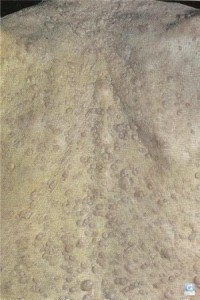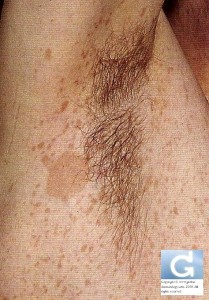Neurofibromatosis
What is Neurofibromatosis ?
- It is part of the phacomatoses and different forms exist.
- It is inherited in an autosomal dominant fashion.
What are the types of neurofibromatosis and what do they look like ?
- Neurofibromatosis type 1 (NF1) is called Von Recklinghausen’s Disease:
- It is most frequently associated with cutaneous alterations.
- It is caused by a mutation on chromosome 17.
- Skin changes present in NF1 include:
- Neurofibromas: these present as rounded promenine flesh-like bumps.
- Café-au-lait macules: big tan patches
- Axillary freckling (also called Crowe’s Sign): small lentigenes in the armpits.
- Itching may be present.
- Internal signs include:
- Lisch nodules: these are proliferations of scar-like tissue in the iris of the eyes
- Skeletal changes (scoliosis…) and tumors in the brain. Therefore imagery is necessary (Radiography, MRI scan (Magnetic Resonance Imagery), CT scan (Computed Tomography).
- Hypertension
- Neurofibromatosis type 2 (NF2) is characterized by bilateral masses in the inner ear (called Schwannomas):
- It is caused by a mutation of chromosome 22.
- Skin changes are the same as in NF1, homever, they are less proment.
How to treat ?
- Prenatal counseling is strongly recommended as therapeutical options are quite limited.
- Tumors need to be monitored for malignant changes and surgery may be needed. For NF2 even after surgery of the inner hear, balance and hearing problems can persist.
- Hypertension and scoliosis can be treated.
- Bothersome neurofibromas may be removed by CO2 laser or electrocauthery.
- Pruritus often responds well to ketotifen.
Bibliography: Sterry W. et al. Thieme Clinical Companions: Dermatology. 1st edition in English
Category : neurofibromatose - Modifie le 03.3.2013Category : neurofibromatosis - Modifie le 03.3.2013




